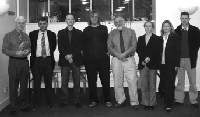SIAM UK and Republic of Ireland Section Holds 2007 Annual Meeting in Oxford
June 12, 2007

Left to right: Nick Trefethen, president of SIAM�s UKIE Section; speakers Andy Woods, Jon Chapman, Andrew Stuart, Cleve Moler, Linda Cummings, and Alison Ramage; and Steve Langdon (secretary/treasurer of the UKIE section). Information about the UKIE Section can be found at http://www.siam.org/join/sections/. The section plans to hold its next annual meeting on January 4, 2008.
The UK and Republic of Ireland section of SIAM held its 11th annual meeting on January 5, 2007, at the Oxford University Computing Laboratory.
The first annual meeting held in Oxford, it was also the largest in some years, and the more than a hundred registered participants included an encouraging number of postgraduate students, a sizeable industrial contingent, and visitors from as far afield as Calais, Paris, Stanford University, and Hong Kong. Indeed, the section is going from strength to strength, with the 187 members in 1996, when the group was founded, having grown to 350 today.
Linda Cummings (Nottingham) opened the meeting with a talk on the mathematical modelling of lipid raft formation. Lipid rafts are lipid/protein microdomain structures, rich in cholesterol and sphingomyelin, found within eukaryotic cell membranes. As (essentially) phase-separated regions within the cell membrane, rafts are believed to have the ability to recruit certain reactants (e.g., proteins) and prevent their interaction with other reactants in the membrane; conversely, they could bring desired reactants into close proximity, thereby promoting certain reactions. Moreover, rafts are implicated in the mechanism of the entry of viruses into cells, and in many cell-signalling processes.
In her talk, Cummings considered the simple model system of a bilayer composed of cholesterol and phosphatidylcholine. She then proposed a mathematical model for raft formation based on considerations of the interactions and formation of bonds between individual cholesterol molecules; comparison of the mathematical model with experimental data revealed very good agreement.
SIAM president Cleve Moler (MathWorks, Inc.) gave a fascinating talk on the evolution of MATLAB over the last 25 years, from a simple matrix calculator to a powerful technical computing environment. Among the examples of MATLAB applications he presented was a particularly interesting analysis of how humans walk. Moler ended with a look toward future developments, including Parallel MATLAB.
First on the program after lunch was Jon Chapman (Oxford), with a talk on the interaction between discrete and continuum models. In many cases in which large numbers of discrete objects are interacting, he said, it is possible to formulate a continuum model in which the discrete objects are replaced by a density (or probability distribution) function. Considering the relation between these discrete and continuous models, Chapman focussed on regions in which the continuous model breaks down and needs to be matched with a discrete local approximation. For examples, he drew on the theory of dislocations, superconductivity, and molecular reaction�diffusion problems.
Andy Woods (Cambridge) discussed the modelling of heat and air flow in buildings, a subject with huge implications for energy-efficient design. In his examples of zero-energy buildings, the main idea is that nature (i.e., gravity and wind) can be used to cool a building at night in such a way that there is no need to use air conditioning during the day. This natural ventilation leads to nonlinear convection with multiple states, and complex time dependence; many challenges arise in describing these detailed flow regimes.
Alison Ramage (Strathclyde) discussed multigrid solution of discrete convection�
diffusion equations. Of interest in their own right, convection�diffusion problems are also closely linked to the Navier�Stokes equations governing incompressible fluid flow, which are widely applicable in industrial settings. One possible approach to their numerical solution is to use a multigrid method, either alone or as a preconditioner with an iterative solver. Ramage presented a matrix-based Fourier analysis of multigrid convergence factors for a two-dimensional model convection�diffusion equation. Having demonstrated the technique with a semiperiodic model problem, she showed that the results are strongly correlated with the properties of the iteration matrix arising from (more practically relevant) Dirichlet problems.
Concluding the meeting, Andrew Stuart (Warwick) considered Monte Carlo Markov chains in high dimensions, an effective and flexible tool for sampling a wide variety of complex probability distributions. Proposal distributions based on simple random walks, and on discretizations of the Langevin equation were introduced, and ideas from numerical analysis were used to construct improved samplers. Stuart illustrated these ideas with application to the sampling of conditioned diffusion processes, an applied area in which the ideas presented have significant practical impact.---Stephen Langdon, University of Reading.

